X,Maybe so but I have noticed increased distortion in sealed vs open baffle or open back boxes with same driver. Even with well damped boxes with appropriate sound absorbing materials on walls and fiberglass fill.
Sounds opposite from your usual standpoint of increased excursion being responsible for distortion.
Care to show HD examples at the same SPL level with the sealed driver (and the cabinet material used) compared to an open baffle?
Art
X,
Sounds opposite from your usual standpoint of increased excursion being responsible for distortion.
Care to show HD examples at the same SPL level with the sealed driver (and the cabinet material used) compared to an open baffle?
Art
The driver was the AC130F1 and perhaps I used it in a bit too small of a cabinet at 5.7 liters, but here is what I mean by increased HD when sealed vs OB.
The cabinet was a recycled Boston HD5 which happens to be a "drop in" fit for the AC130F1. I had a good size wad of factory polyfill from Boston inside (not shown in photo below). More info in this thread:
http://www.diyaudio.com/forums/full-range/280331-fr58ex-ac130f1-micro-fast.html
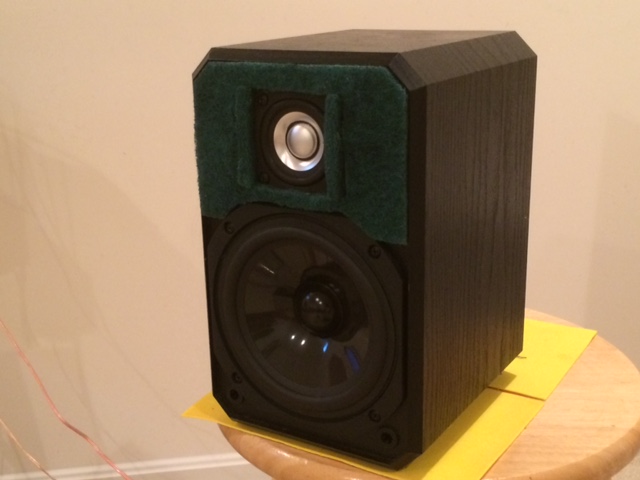
Here is the OB and sealed data at same 2.83v drive level:
OB case:
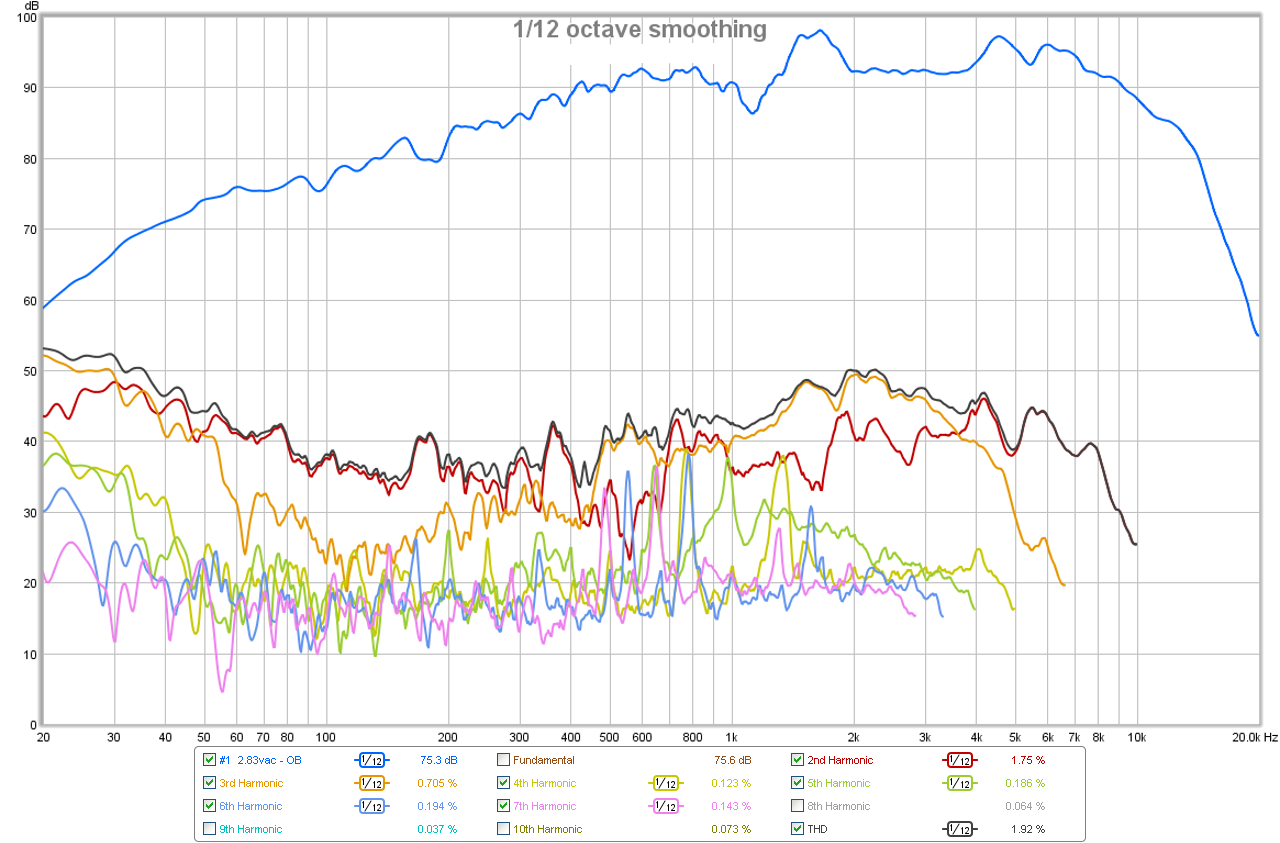
Notice the broad HD peak centered at 60Hz for sealed case:
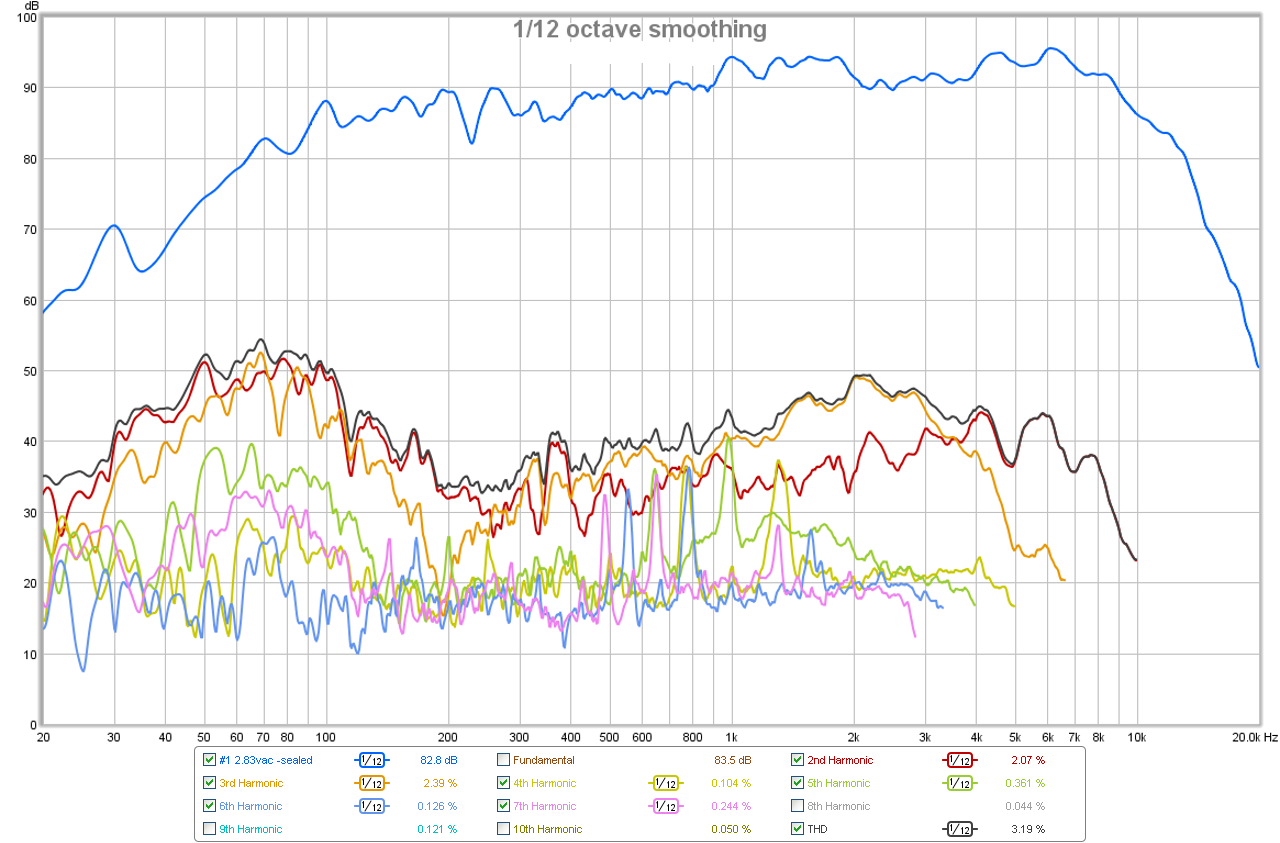
Attachments
Last edited:
Is that from the sealed enclosure, the LT or one of the two defective drivers you received in your order?
Since the system is first order and the the FR58 is not in a seperate chamber, there's not much inference to make as to %THD of the woofer only.
To blame the rise in HD on a sealed alignment is nothing more than a shot in the dark with a crooked barrel.
Your measurements in this particular case are suspect........and asking 50hz response from a 5 inch woofer isn't useful data either way.
Since the system is first order and the the FR58 is not in a seperate chamber, there's not much inference to make as to %THD of the woofer only.
To blame the rise in HD on a sealed alignment is nothing more than a shot in the dark with a crooked barrel.
Your measurements in this particular case are suspect........and asking 50hz response from a 5 inch woofer isn't useful data either way.
Last edited:
That is from one of the two defective drivers - they exhibited the same problem. The "good driver" had about 1% HD vs 3% HD at 60Hz. The data was taken with the driver connected to an amp with no miniDSP and running full range. So no LT involved - just native response in sealed vs OB.
If you would have read the thread, you would have noticed that the FR58 has a separate chamber - a 4-sided Dagger sealed TL clearly visible here:
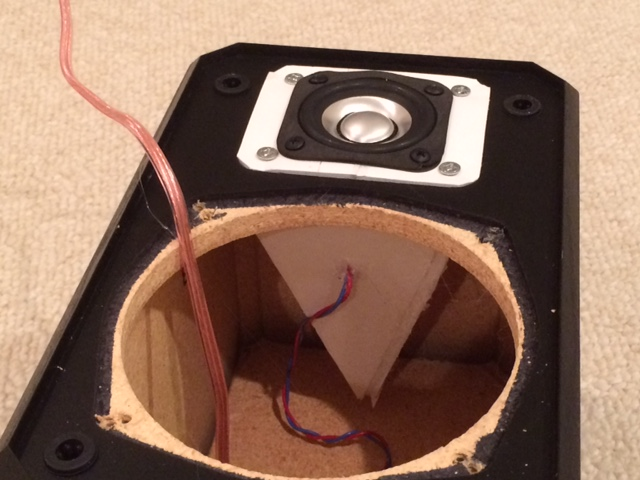
The vendor claimed that since the two drivers that had the higher distortion when sealed did not exhibit that distortion as an OB, thus, there was nothing wrong with them. The one driver that did not have the problem was the anomaly.
You are so quick to blame my suspect measurement methods. I know what I am doing, have good gear, and good measurement practices.
I am not blaming a sealed alignment, but said to be on the lookout for increased HD with a sealed as that has been my observation for several instances for the AC130 and for the DC200 used for the speaker in this thread. That is why I am upgrading to RS180P.
I have shown data, do you have data that says a sealed does not have more HD than an open baffle, open back, or vented alignment even?
Since the system is first order and the the FR58 is not in a seperate chamber, there's not much inference to make as to %THD of the woofer only.
If you would have read the thread, you would have noticed that the FR58 has a separate chamber - a 4-sided Dagger sealed TL clearly visible here:

The vendor claimed that since the two drivers that had the higher distortion when sealed did not exhibit that distortion as an OB, thus, there was nothing wrong with them. The one driver that did not have the problem was the anomaly.
Your measurements in this particular case are suspect........and asking 50hz response from a 5 inch woofer isn't useful data either way.
You are so quick to blame my suspect measurement methods. I know what I am doing, have good gear, and good measurement practices.
To blame the rise in HD on a sealed alignment is nothing more than a shot in the dark with a crooked barrel.
I am not blaming a sealed alignment, but said to be on the lookout for increased HD with a sealed as that has been my observation for several instances for the AC130 and for the DC200 used for the speaker in this thread. That is why I am upgrading to RS180P.
I have shown data, do you have data that says a sealed does not have more HD than an open baffle, open back, or vented alignment even?
Last edited:
I don't think sealed enclosures have to have higher HD levels. But it takes work to make sure that doesn't happen. Start with an impedance plot and look up close. Most "standard" enclosures would add to the sound. Remember your un-damped foam core horns? The difference afterwards with CLD damping?
Now why would that be different with a sealed enclosure. Just another part of the FR got into trouble due to different materials and sizes.
Bushmeister has shown quite impressive data and went to greater length to get the enclosure as right as possible. All it takes is some research and a lot of work to get it better. Don't blame the alignment, blame the execution. Just my opinion.
Now why would that be different with a sealed enclosure. Just another part of the FR got into trouble due to different materials and sizes.
Bushmeister has shown quite impressive data and went to greater length to get the enclosure as right as possible. All it takes is some research and a lot of work to get it better. Don't blame the alignment, blame the execution. Just my opinion.
In order to compare the two distortion measurements of OB vs sealed the OB needs to be to EQ'd to roughly the same target as the sealed.
As the OB version drops steadily in output from 600Hz down and is producing a significantly lower output it is not a fair comparison to judge the HD produced.
The measurements look good to me but is a little bit of an apples and pears comparison. If you could EQ the OB to have a similar output then this would be a very good way to compare the same driver in OB vs sealed.
I don't know how REW works out the distortion percentages but the sealed actually looks to be lower than the OB when compared to the fundamental particularly from 50Hz down.
As the OB version drops steadily in output from 600Hz down and is producing a significantly lower output it is not a fair comparison to judge the HD produced.
The measurements look good to me but is a little bit of an apples and pears comparison. If you could EQ the OB to have a similar output then this would be a very good way to compare the same driver in OB vs sealed.
I don't know how REW works out the distortion percentages but the sealed actually looks to be lower than the OB when compared to the fundamental particularly from 50Hz down.
Agreed. One problem with the sealed alignment that doesn't really exist for other alignments, especially with EQ (or LT) is very high pressures. A small sealed box can easily have inside pressures 30 dB above the outside pressures which causes a lot of stress on the cone and produce a lot of force on the enclosure that need to be handled.I don't think sealed enclosures have to have higher HD levels. But it takes work to make sure that doesn't happen. Start with an impedance plot and look up close. Most "standard" enclosures would add to the sound. Remember your un-damped foam core horns? The difference afterwards with CLD damping?
Now why would that be different with a sealed enclosure. Just another part of the FR got into trouble due to different materials and sizes.
Bushmeister has shown quite impressive data and went to greater length to get the enclosure as right as possible. All it takes is some research and a lot of work to get it better. Don't blame the alignment, blame the execution. Just my opinion.
I also agree with fluid that the response needs to be EQd to compare. Another thing that makes it difficult is that the higher directivity of the OB will reduce reflections and it will therefore sound cleaner.
/Anton
Agreed that execution is important but I think what is happening here is the high pressures of an overly small cabinet as Onni pointed out. Bushmeister indeed spent a lot of care but his box is way bigger. I did not show you my data yet as it was still being worked but the DC200 had a huge increase in HD once sealed. I went in and added a combination of 1im and 2.5in thick acoustic egg crate foam on all internal surfaces and a layer of 3.5in thick fiberglass. There was no decrease in measured HD from the plain stuffed with fiberglass case. The eggcrate foam is used in a lot of sealed cabinets as the main form of sound absorber so I think I can say that I made a significant effort to damp the back wave. The Vas on the DC200 is 45 liters and I had two of them in a 30liter cabinet. About 1/3 of Vas - a bit undersized. Consequently pressure will be high relative to natural compliance of speaker. On the AC130F1 Vas is 36liters and I had it in about 6liters. This is very small but I thought not too far from the 7.5litet that Bagby uses for the Continuum. I have never seen a published HD curve for a continuum but wonder how it fares. It uses only eggcrate foam as absorber inside.
I disagree that the OB has to be EQ'd to see effect. OB already has more excursion than sealed because of lack of air spring. Normally, lower excursion means lower HD. To EQ the OB to move more is actually the wrong way. If anything I want to compare HD for same stroke. I am not comparing performance of bass capability of OB vs sealed to see what HD is. I am looking for why HD would rise for a system that moves less.
Anyhow - I switched to the RS180P drivers - they are a bit smaller so the box is relatively bigger, they have a smaller Vas, and the motor is lower distortion. The results were immediately apparent when I measured it. HD is now around 1% at 80Hz vs 4% for the DC200 at the same drive level. The sensitivity went up so SPL is actually higher. More importantly, several of the really high 3rd harmonic peaks disappeared completely. It sounds much cleaner and the improvement was immediate. I suspect mostly the problem I have been seeing is over pressurization due to a small cabinet. Not all drivers handle it well and I do believe there is some non linear air compression distortion going on due to the extreme small volume that suffers more compression than a larger box.
Here are RS180P-8's mounted. Yellow thing on horn is a ball of putty used to block hole to test speaker without the mid tweeter installed.
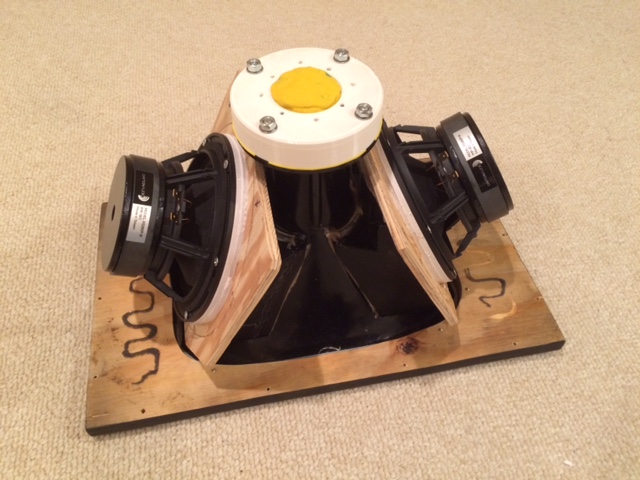
I disagree that the OB has to be EQ'd to see effect. OB already has more excursion than sealed because of lack of air spring. Normally, lower excursion means lower HD. To EQ the OB to move more is actually the wrong way. If anything I want to compare HD for same stroke. I am not comparing performance of bass capability of OB vs sealed to see what HD is. I am looking for why HD would rise for a system that moves less.
Anyhow - I switched to the RS180P drivers - they are a bit smaller so the box is relatively bigger, they have a smaller Vas, and the motor is lower distortion. The results were immediately apparent when I measured it. HD is now around 1% at 80Hz vs 4% for the DC200 at the same drive level. The sensitivity went up so SPL is actually higher. More importantly, several of the really high 3rd harmonic peaks disappeared completely. It sounds much cleaner and the improvement was immediate. I suspect mostly the problem I have been seeing is over pressurization due to a small cabinet. Not all drivers handle it well and I do believe there is some non linear air compression distortion going on due to the extreme small volume that suffers more compression than a larger box.
Here are RS180P-8's mounted. Yellow thing on horn is a ball of putty used to block hole to test speaker without the mid tweeter installed.

Attachments
Last edited:
Great you have progress xrk971, gave you some exstra work but now we know FR58EX and DC200-8 work not as good as SB65WBAC25-4 and RS180P in your build, have best progress and fun from now on with the build and look forward see new data down the road.
Thanks Byrtt. I really like how the RS180P looks and feels - have not had a chance to listen to it yet but suspect it sounds nice given the very flat response curve. I would like to make a small open face 2 way with it at some point.
I am getting quite a high bandpass overshoot peak near 500Hz - I suspect the small holes may need to be enlarged to increase cross sectional area. Or add more holes maybe. I still need to make the rear chamber for the SB65 - falling behind on that one.
I am getting quite a high bandpass overshoot peak near 500Hz - I suspect the small holes may need to be enlarged to increase cross sectional area. Or add more holes maybe. I still need to make the rear chamber for the SB65 - falling behind on that one.
Here's a quick and dirty experiment for ya......take any of your full range drivers and seal em up in one of your foam core boxes.......no exit, just an internal support for the driver and take a listen and even some HD sweeps. I think you'll be surprised how much the enclosure is contributing.
They sound........wonderful!
Time to look at the lower sub cabs so they don't have to sit on stools any more!
Maybe two 15 inch PD woofers is the way to go......
Time to look at the lower sub cabs so they don't have to sit on stools any more!
Maybe two 15 inch PD woofers is the way to go......
Attachments
Last edited:
Here's a quick and dirty experiment for ya......take any of your full range drivers and seal em up in one of your foam core boxes.......no exit, just an internal support for the driver and take a listen and even some HD sweeps. I think you'll be surprised how much the enclosure is contributing.
Don't you think I have done this a million times? Have you seen what my sealed tapered spiral TL can do? Essentially no coloration - same as OB. The Dagger is just as good only much more compact. No parallel walls, foam around regions near driver and either polyfill or fiberglass stuffing progressively denser towards vertex.
http://www.diyaudio.com/forums/full...parison-3in-4in-class-full-range-drivers.html
Here is comparison of Nautaloss with trapezoidal baffle vs OB for CHN70:
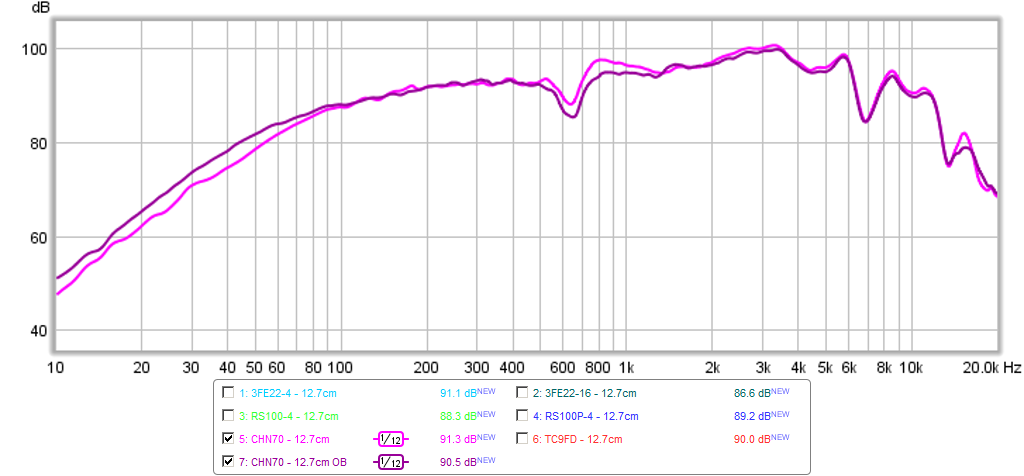
They sound........wonderful!
Time to look at the lower sub cabs so they don't have to sit on stools any more!
Maybe two 15 inch PD woofers is the way to go......
Those are some excellent measured performance. How does it sound in stereo? Imaging and sound stage quality?
Very impressive speakers actually. The HD and GD and phase are all excellent.
Best I have ever heard. It makes me realise the details lost to the room. I have only had a brief listening session in stereo, cause I am now painting the second one black.
As you have found, stuffing does not affect distortion directly.I went in and added a combination of 1im and 2.5in thick acoustic egg crate foam on all internal surfaces and a layer of 3.5in thick fiberglass. There was no decrease in measured HD from the plain stuffed with fiberglass case. The eggcrate foam is used in a lot of sealed cabinets as the main form of sound absorber so I think I can say that I made a significant effort to damp the back wave.
I disagree that the OB has to be EQ'd to see effect. OB already has more excursion than sealed because of lack of air spring. Normally, lower excursion means lower HD. To EQ the OB to move more is actually the wrong way. If anything I want to compare HD for same stroke. I am not comparing performance of bass capability of OB vs sealed to see what HD is. I am looking for why HD would rise for a system that moves less.
Fiberglass or foam won't damp low frequency sound waves, the material is typically used in sealed cabinets to increase the apparent box volume by 15-18% by adding isothermal mass, which lowers the Fcb (closed box resonant frequency).
The HD rises because the sealed driver is doing more work- around 10 dB more SPL is being produced just above the frequency where you noted the rise in HD. Increase the voltage in the open baffle driver to achieve that level and it's distortion level will also rise accordingly, and would likely be considerably higher than the sealed.
When comparing distortion levels between the same driver in bass reflex and tapped horns, the TH had about 6 dB more SPL for a given voltage, and had lower distortion levels than the BR. However, the TH had more distortion for a given excursion than the BR, like your sealed vs OB example, distortion is work related, not just excursion related.
This is why I asked for examples at the same SPL level (not voltage) with the sealed driver compared to an open baffle.
You could see the difference in the work the driver is doing to by looking at the impedance curve, the impedance peak in the box has been driven up from it's Fs (35 Hz free air resonance) to above the frequency region of the rising distortion level. Below Fcb, the distortion level remains constant (the small box limiting excursion), while the OB distortion rises.
Art
So you are saying its normal to see 3% to 10% HD below 100Hz in sealed bass boxes? Bushmeister obviously was able to achieve a much lower figure of under 1% at 100dB.
Don't you think I have done this a million times? Have you seen what my sealed tapered spiral TL can do? Essentially no coloration - same as OB. The Dagger is just as good only much more compact. No parallel walls, foam around regions near driver and either polyfill or fiberglass stuffing progressively denser towards vertex.
http://www.diyaudio.com/forums/full...parison-3in-4in-class-full-range-drivers.html
Here is comparison of Nautaloss with trapezoidal baffle vs OB for CHN70:

that's not what i meant.....at least i think.
I'm saying a box with NO exit.....the driver radiates inside the box only
3% to 10% (or more) HD below 100Hz in any type of enclosure is "normal", depending on SPL, distance and boundaries.So you are saying its normal to see 3% to 10% HD below 100Hz in sealed bass boxes? Bushmeister obviously was able to achieve a much lower figure of under 1% at 100dB.
Obviously, Bushmeister's larger box with two larger drivers does have lower distortion than a smaller box with one smaller driver at a given level.
Hoffman's iron law at work: low, loud, small, pick two. You can't expect much clean bass from a pint sized box.
Art
Last edited:
- Home
- Loudspeakers
- Multi-Way
- A Bookshelf Multi-Way Point-Source Horn








